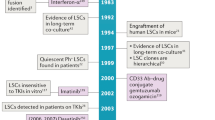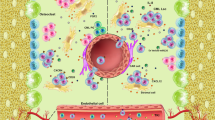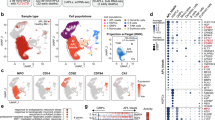Abstract
A fundamental issue in cancer biology is the identification of the target cell in which the causative molecular lesion arises. Acute myeloid leukemia (AML) is thought to reflect the transformation of a primitive stem cell compartment. The resultant ‘cancer stem cells’ comprise only a minor portion of the leukemic clone but give rise through differentiation to more committed progenitors as well as differentiated blasts that constitute the bulk of the tumor. The maintenance of the leukemic clone is dependent on the self-renewal capacity of the cancer stem cell compartment, which is revealed by its ability to re-initiate leukemia in a transplant setting. The cellular basis of acute promyelocytic leukemia (APL) is however less clear. APL has traditionally been considered to be the most differentiated form of AML and to arise from a committed myeloid progenitor. Here we review apparently conflicting evidence pertaining to the cellular origins of APL and propose that this leukemia may originate in more than one cellular compartment. This view could account for many apparent inconsistencies in the literature to date. An understanding of the nature of the target cell involved in transformation of APL has important implications for biological mechanism and for clinical treatment.
This is a preview of subscription content, access via your institution
Access options
Subscribe to this journal
Receive 12 print issues and online access
$259.00 per year
only $21.58 per issue
Buy this article
- Purchase on Springer Link
- Instant access to full article PDF
Prices may be subject to local taxes which are calculated during checkout



Similar content being viewed by others
References
Mistry AR, Wessel Pedersen E, Solomon E, Grimwade D . The molecular pathogenesis of acute promyelocytic leukaemia: implications for the clinical management of the disease. Blood Rev 2003; 17: 71–97.
Ohno R, Asou N, Ohnishi K . Treatment of acute promyelocytic leukemia. Strategy toward further increase of cure rate. Leukemia 2003; 17: 1454–1463.
Bennett JM, Catovsky D, Daniel MT, Flandrin G, Galton DA, Gralnick HR et al. Proposals for the classification of acute leukaemias. French–American–British (FAB) co-operative group. Br J Haematol 1976; 33: 451–458.
Bennett JM, Catovsky D, Daniel MT, Flandrin G, Galton DA, Gralnick HR et al. Proposed revised criteria for the classification of acute myeloid leukaemia. A report of the French–American–British cooperative group. Ann Intern Med 1985; 103: 620–625.
Collins SJ . The role of retinoids and retinoic acid receptors in normal hematopoiesis. Leukemia 2002; 16: 1896–1905.
Redner RL . Variations on a theme: the alternate translocations in APL. Leukemia 2002; 16: 1927–1932.
Pitha-Rowe I, Petty WJ, Kitareewan S, Dmitrovsky E . Retinoid target genes in acute promyelocytic leukemia. Leukemia 2003; 17: 1723–1730.
Di Croce L, Raker VA, Corsaro M, Fazi F, Fanelli M, Faretta M et al. Methyltransferase recruitment and DNA hypermethylation of target promoters by an oncogenic transcription factor. Science 2002; 295: 1079–1082.
Altucci L, Rossin A, Raffelsberger W, Reitmair A, Chomienne C, Gronemeyer H . Retinoic acid-induced apoptosis in leukemia cells is mediated by paracrine action of tumor-selective death ligand TRAIL. Nat Med 2001; 7: 680–686.
Zhu J, Lallemand-Breitenbach V, de Thé H . Pathways of retinoic acid- or arsenic trioxide-induced PML/RARα catabolism, role of oncogene degradation in disease remission. Oncogene 2001; 20: 7257–7265.
Hong SH, David G, Wong CW, Dejean A, Privalsky ML . SMRT corepressor interacts with PLZF and with the PML-retinoic acid receptor α (RARα) and PLZF-RARα oncoproteins associated with acute promyelocytic leukemia. Proc Natl Acad Sci USA 1997; 94: 9028–9033.
Guidez F, Ivins S, Zhu J, Söderström M, Waxman S, Zelent A . Reduced retinoic acid sensitivities of nuclear receptor corepressor binding to PML- and RARA underlie molecular pathogenesis and treatment of acute promyelocytic leukemia. Blood 1998; 91: 2634–2642.
He LZ, Guidez F, Tribioli C, Peruzzi D, Ruthardt M, Zelent A et al. Distinct interactions of PML-RARα and PLZF-RARα with co-repressors determine differential responses to RA in APL. Nat Genet 1998; 18: 126–134.
Grignani F, De Matteis S, Nervi C, Tomassoni L, Gelmetti V, Cioce M et al. Fusion proteins of the retinoic acid receptor-α recruit histone deacetylase in acute promyelocytic leukaemia. Nature 1998; 391: 815–818.
Lin RJ, Nagy L, Inoue S, Shao W, Miller WH, Evans RM . Role of the histone deacetylase complex in acute promyelocytic leukaemia. Nature 1998; 391: 811–814.
Yoshida H, Naoe T, Fukutani H, Kiyoi H, Kubo K, Ohno R . Analysis of the joining sequences of the t(15;17) translocation in acute promyelocytic leukemia: sequence non-specific recombination between the PML and RARA genes within identical short stretches. Genes Chromosomes Cancer 1995; 12: 37–44.
Reiter A, Sauβele S, Grimwade D, Wiemels JL, Segal MR, Lafage-Pochitaloff M et al. Genomic anatomy of the specific reciprocal translocation t(15;17) in acute promyelocytic leukemia. Genes Chromosomes Cancer 2003; 36: 175–188.
Shet AS, Jahagirdar BN, Verfaillie CM . Chronic myelogenous leukemia: mechanisms underlying disease progression. Leukemia 2002; 16: 1402–1411.
Kantarjian HM, Keating MJ, Talpaz M, Walters RS, Smith TL, Cork A et al. Chronic myelogenous leukemia in blast crisis. Analysis of 242 patients. Am J Med 1987; 83: 445–454.
Bonnet D, Dick JE . Human acute myeloid leukemia is organized as a hierarchy that originates from a primitive hematopoietic cell. Nat Med 1997; 3: 730–737.
Ailles LE, Gerhard B, Kawagoe H, Hogge DE . Growth characteristics of acute myelogenous leukemia progenitors that initiate malignant hematopoiesis in nonobese diabetic/severe combined immunodeficient mice. Blood 1999; 94: 1761–1772.
Guan Y, Gerhard B, Hogge DE . Detection, isolation, and stimulation of quiescent primitive leukemic progenitor cells from patients with acute myeloid leukemia (AML). Blood 2003; 101: 3142–3149.
Al-Hajj M, Wicha MS, Benito-Hernandez A, Morrison SJ, Clarke MF . Prospective identification of tumorigenic breast cancer cells. Proc Natl Acad Sci USA 2003; 100: 3983–3988.
Welm BE, Tepera SB, Venezia T, Graubert TA, Rosen JM, Goodell MA . Sca-1(pos) cells in the mouse mammary gland represent an enriched progenitor cell population. Dev Biol 2002; 245: 42–56.
Alvi AJ, Clayton H, Joshi C, Enver T, Ashworth A, Vivanco MM et al. Functional and molecular characterisation of mammary side population cells. Breast Cancer Res 2003; 5: R1–8.
Scharenberg CW, Harkey MA, Torok-Storb B . The ABCG2 transporter is an efficient Hoechst 33342 efflux pump and is preferentially expressed by immature human hematopoietic progenitors. Blood 2002; 99: 507–512.
Williams GT . Programmed cell death: apoptosis and oncogenesis. Cell 1991; 65: 1097–1098.
Graham SM, Jorgensen HG, Allan E, Pearson C, Alcorn MJ, Richmond L et al. Primitive, quiescent, Philadelphia-positive stem cells from patients with chronic myeloid leukemia are insensitive to STI571 in vitro. Blood 2002; 99: 319–325.
Hochhaus A . Minimal residual disease in chronic myeloid leukaemia patients. Best Pract Res Clin Haematol 2002; 15: 159–178.
Turhan AG, Lemoine FM, Debert C, Bonnet ML, Baillou C, Picard F et al. Highly purified primitive hematopoietic stem cells are PML-RARA negative and generate nonclonal progenitors in acute promyelocytic leukemia. Blood 1995; 85: 2154–2161.
Brown D, Kogan S, Lagasse E, Weissman I, Alcalay M, Pelicci PG et al. A PML-RARα transgene initiates murine acute promyelocytic leukemia. Proc Natl Acad Sci USA 1997; 94: 2551–2556.
Grisolano JL, Wesselschmidt RL, Pelicci PG, Ley TJ . Altered myeloid development and acute leukemia in transgenic mice expressing PML-RARα under control of cathepsin G regulatory sequences. Blood 1997; 89: 376–387.
He LZ, Tribioli C, Rivi R, Peruzzi D, Pelicci PG, Soares V et al. Acute-leukemia with promyelocytic features in PML/RARα transgenic mice. Proc Natl Acad Sci USA 1997; 94: 5302–5307.
Westervelt P, Lane AA, Pollock JL, Oldfather K, Holt MS, Zimonjic DB et al. A high penetrance mouse model of acute promyelocytic leukemia with very low levels of PML-RARα expression. Blood 2003; 102: 1857–1865.
Westervelt P, Ley TJ . Seed vs soil: The importance of the target cell for transgenic models of human leukemias. Blood 1999; 93: 2143–2148.
Early E, Moore MA, Kakizuka A, Nason-Burchenal K, Martin P, Evans RM et al. Transgenic expression of PML/RARα impairs myelopoiesis. Proc Natl Acad Sci USA 1996; 93: 7900–7904.
Vickers M, Jackson G, Taylor P . The incidence of acute promyelocytic leukemia appears constant over most of a human lifespan, implying only one rate limiting mutation. Leukemia 2000; 14: 722–726.
Guglielmi C, Martelli MP, Diverio D, Fenu S, Vegna ML, Cantù-Rajnoldi A et al. Immunophenotype of adult and childhood acute promyelocytic leukaemia: correlation with morphology, type of PML gene breakpoint and clinical outcome. A cooperative Italian study on 196 cases. Br J Haematol 1998; 102: 1035–1041.
Murray CK, Estey E, Paietta E, Howard RS, Edenfield WJ, Pierce S et al. CD56 expression in acute promyelocytic leukemia: a possible indicator of poor treatment outcome? J Clin Oncol 1999; 17: 293–297.
Ferrara F, Morabito F, Martino B, Specchia G, Liso V, Nobile F et al. CD56 expression is an indicator of poor clinical outcome in patients with acute promyelocytic leukemia treated with simultaneous all-trans-retinoic acid and chemotherapy. J Clin Oncol 2000; 18: 1295–1300.
Biondi A, Luciano A, Bassan R, Mininni D, Specchia G, Lanzi E et al. CD2 expression in acute promyelocytic leukemia is associated with microgranular morphology (FAB M3v) but not with any PML gene breakpoint. Leukemia 1995; 9: 1461–1466.
Grimwade D, Outram SV, Flora R, Ings S, Pizzey AR, Morilla R et al. The T-lineage-affiliated CD2 gene lies within an open chromatin environment in acute promyelocytic leukemia cells. Cancer Res 2002; 62: 4730–4735.
Claxton DF, Reading CL, Nagarajan L, Tsujimoto Y, Andersson BS, Estey E et al. Correlation of CD2 expression with PML gene breakpoints in patients with acute promyelocytic leukemia. Blood 1992; 80: 582–586.
Foley R, Soamboonsrup P, Carter RF, Benger A, Meyer R, Walker I et al. CD34-positive acute promyelocytic leukemia is associated with leukocytosis, microgranular/hypogranular morphology, expression of CD2 and bcr3 isoform. Am J Hematol 2001; 67: 34–41.
Smith LJ, Curtis JE, Messner HA, Senn JS, Furthmayr H, McCulloch EA . Lineage infidelity in acute leukemia. Blood 1983; 61: 1138–1145.
Greaves MF, Chan LC, Furley AJW, Watt SM, Molgaard HV . Lineage promiscuity in hemopoietic differentiation and leukemia. Blood 1986; 67: 1–11.
Hu M, Krause D, Greaves M, Sharkis S, Dexter M, Heyworth C et al. Multilineage gene expression precedes commitment in the hemopoietic system. Genes Dev 1997; 11: 774–785.
Miyamoto T, Iwasaki H, Reizis B, Ye M, Graf T, Weissman IL et al. Myeloid or lymphoid promiscuity as a critical step in hematopoietic lineage commitment. Dev Cell 2002; 3: 137–147.
Akashi K, He X, Chen J, Iwasaki H, Niu C, Steenhard B et al. Transcriptional accessibility for genes of multiple tissues and hematopoietic lineages is hierarchically controlled during early hematopoiesis. Blood 2003; 101: 383–389.
So CW, Karsunky H, Passegue E, Cozzio A, Weissman IL, Cleary ML . MLL-GAS7 transforms multipotent hematopoietic progenitors and induces mixed lineage leukemias in mice. Cancer Cell 2003; 3: 161–171.
Edwards RH, Wasik MA, Finan J, Rodriguez R, Moore J, Kamoun M et al. Evidence for early hematopoietic progenitor cell involvement in acute promyelocytic leukemia. Am J Clin Pathol 1999; 112: 819–827.
Cheng GX, Zhu XH, Men XQ, Wang L, Huang QH, Jin XL et al. Distinct leukemia phenotypes in transgenic mice and different corepressor interactions generated by promyelocytic leukemia variant fusion genes PLZF-RARα and NPM-RARα. Proc Natl Acad Sci USA 1999; 96: 6318–6323.
Le Beau MM, Davis EM, Patel B, Phan VT, Sohal J, Kogan SC . Recurring chromosomal abnormalities in leukemia in PML-RARA transgenic mice identify cooperating events and genetic pathways to acute promyelocytic leukemia. Blood 2003; 102: 1072–1074.
Zimonjic DB, Pollock JL, Westervelt P, Popescu NC, Ley TJ . Acquired, non-random chromosomal abnormalities associated with the development of acute promyelocytic leukemia in transgenic mice. Proc Natl Acad Sci USA 2000; 97: 13306–13311.
Pollock JL, Westervelt P, Kurichety AK, Pelicci PG, Grisolano JL, Ley TJ . A bcr-3 isoform of RARα-PML potentiates the development of PML-RARα-driven acute promyelocytic leukemia. Proc Natl Acad Sci USA 1999; 96: 15103–15108.
Kelly LM, Kutok JL, Williams IR, Boulton CL, Amaral SM, Curley DP et al. PML/RARα and FLT-ITD induce an APL-like disease in a mouse model. Proc Natl Acad Sci USA 2002; 99: 8283–8288.
Sohal J, Phan VT, Chan PV, Davis EM, Patel B, Kelly LM et al. A model of APL with FLT3 mutation is responsive to retinoic acid and a receptor tyrosine kinase inhibitor, SU11657. Blood 2003; 101: 3188–3197.
Kogan SC, Brown DE, Schultz DB, Truong B-TH, Lallemand-Breitenbach V, Guillemin MC et al. BCL-2 cooperates with promyelocytic retinoic acid receptor α chimeric protein (PML-RARα) to block neutrophil differentiation and initiate leukemia. J Exp Med 2001; 193: 531–543.
He LZ, Bhaumik M, Tribioli C, Rego EM, Ivins S, Zelent A et al. Two critical hits for promyelocytic leukemia. Mol Cell 2000; 6: 1131–1141.
Minucci S, Monestiroli S, Giavara S, Ronzoni S, Marchesi F, Insinga A et al. PML-RAR induces promyelocytic leukemias with high efficiency following retroviral gene transfer into purified murine hematopoietic progenitors. Blood 2002; 100: 2989–2995.
Grignani F, Valtieri M, Gabbianelli M, Gelmetti V, Botta R, Luchetti L et al. PML/RARα fusion protein expression in normal human hematopoietic progenitors dictates myeloid commitment and the promyelocytic phenotype. Blood 2000; 96: 1531–1537.
Hao QL, Thiemann FT, Petersen D, Smogorzewska EM, Crooks GM . Extended long-term culture reveals a highly quiescent and primitive human hematopoietic progenitor population. Blood 1996; 88: 3306–3313.
Lapidot T, Sirard C, Vormoor J, Murdoch B, Hoang T, Caceres-Cortes J et al. A cell initiating human acute myeloid leukaemia after transplantation into SCID mice. Nature 1994; 367: 645–648.
Blair A, Hogge DE, Ailles LE, Lansdorp PM, Sutherland HJ . Lack of expression of Thy-1 (CD90) on acute myeloid leukemia cells with long-term proliferative ability in vitro and in vivo. Blood 1997; 89: 3104–3112.
Blair A, Hogge DE, Sutherland HJ . Most acute myeloid leukemia progenitor cells with long-term proliferative ability in vitro and in vivo have the phenotype CD34(+)/CD71(−)/HLA−DR−. Blood 1998; 92: 4325–4335.
Haferlach T, Loffler H, Nickenig C, Ramm-Petersen L, Meeder M, Schoch R et al. Cell lineage specific involvement in acute promyelocytic leukaemia (APL) using a combination of May–Grunwald–Giemsa staining and fluorescence in situ hybridization techniques for the detection of the translocation t(15;17)(q22;q12). Br J Haematol 1998; 103: 93–99.
Knuutila S, Teerenhovi L, Larramendy ML, Elonen E, Franssila KO, Nylund SJ et al. Cell lineage involvement of recurrent chromosomal abnormalities in hematologic neoplasms. Genes Chromosomes Cancer 1994; 10: 95–102.
Takatsuki H, Sadamura S, Umemura T, Abe Y, Goto T, Yufu Y et al. PML/RARα fusion gene is expressed in both granuloid/macrophage and erythroid colonies in acute promyelocytic leukaemia. Br J Haematol 1993; 85: 477–482.
Kondo M, Scherer DC, Miyamoto T, King AG, Akashi K, Sugamura K et al. Cell-fate conversion of lymphoid-committed progenitors by instructive actions of cytokines. Nature 2000; 407: 383–386.
Heyworth C, Pearson S, May G, Enver T . Transcription factor-mediated lineage switching reveals plasticity in primary committed progenitor cells. EMBO J 2002; 21: 3770–3781.
Graf T . Differentiation plasticity of hematopoietic cells. Blood 2002; 99: 3089–3101.
Asnafi V, Radford-Weiss I, Dastugue N, Bayle C, Leboeuf D, Charrin C et al. CALM-AF10 is a common fusion transcript in T-ALL and is specific to the TCRγδ lineage. Blood 2003; 102: 1000–1006.
Ferrucci PF, Grignani F, Pearson M, Fagioli M, Nicoletti I, Pelicci PG . Cell death induction by the promyelocytic leukemia-specific PML/RARα fusion protein. Proc Natl Acad Sci USA 1997; 94: 10901–10906.
Lu M, Kawamoto H, Katsube Y, Ikawa T, Katsura Y . The common myelolymphoid progenitor: a key intermediate stage in hemopoiesis generating T and B cells. J Immunol 2002; 169: 3519–3525.
Katsura Y . Redefinition of lymphoid progenitors. Nat Rev Immunol 2002; 2: 127–132.
Kiyoi H, Naoe T, Yokota S, Nakao M, Minami S, Kuriyama K et al. Internal tandem duplication of FLT3 associated with leukocytosis in acute promyelocytic leukemia. Leukemia Study Group of the Ministry of Health and Welfare (Kohseisho). Leukemia 1997; 11: 1447–1452.
Noguera NI, Breccia M, Divona M, Diverio D, Costa V, De Santis S et al. Alterations of the FLT3 gene in acute promyelocytic leukemia: association with diagnostic characteristics and analysis of clinical outcome in patients treated with the Italian AIDA protocol. Leukemia 2002; 16: 2185–2189.
Shih LY, Kuo MC, Liang DC, Huang CF, Lin TL, Wu JH et al. Internal tandem duplication and Asp835 mutations of the FMS-like tyrosine kinase 3 (FLT3) gene in acute promyelocytic leukemia. Correlation with molecular subtypes of PML/RARα and clinical features. Cancer 2003; 98: 1206–1216.
Lane AA, Ley TJ . Neutrophil elastase cleaves PML-RARα and is important for the development of acute promyelocytic leukemia in mice. Cell 2003; 115: 305–318.
Acknowledgements
DG is supported by the Leukaemia Research Fund of Great Britain. TE is supported by the MRC and a specialist programme from the Leukaemia Research Fund of Great Britain.
Author information
Authors and Affiliations
Corresponding authors
Rights and permissions
About this article
Cite this article
Grimwade, D., Enver, T. Acute promyelocytic leukemia: where does it stem from?. Leukemia 18, 375–384 (2004). https://doi.org/10.1038/sj.leu.2403234
Received:
Accepted:
Published:
Issue Date:
DOI: https://doi.org/10.1038/sj.leu.2403234
Keywords
This article is cited by
-
A humanized bone marrow ossicle xenotransplantation model enables improved engraftment of healthy and leukemic human hematopoietic cells
Nature Medicine (2016)
-
Heterogeneity of clonal expansion and maturation-linked mutation acquisition in hematopoietic progenitors in human acute myeloid leukemia
Leukemia (2014)
-
Flow cytometry analysis of acute promyelocytic leukemia: the power of ‘surface hematology’
Leukemia (2007)
-
Phosphoinositide 3-kinase/Akt signaling pathway and its therapeutical implications for human acute myeloid leukemia
Leukemia (2006)



